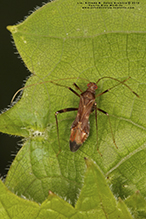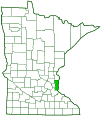Plant bug
(Paraxenetus guttulatus)
Conservation • Description • Habitat • Ecology • Distribution • Taxonomy
Conservation Status |
|||
| IUCN Red List | not listed |
||
| NatureServe | not listed |
||
| Minnesota | not listed |
||
Description
Paraxenetus guttulatus is a small, soft-bodied, plant bug. It occurs in the eastern United States and in Ontario, Canada. It is rare in Minnesota, where it is beyond its previously known range. They are found on grape and possibly also on dogwood.
Adults are slender, elongated, and slightly constricted in the middle. Males are ¼″ (6.4 mm) long and 1⁄32″ (1.33 mm) wide, females are slightly larger, ¼″ (6.8 mm) long and 1⁄32″ (1.51 mm) wide. The body is and dark grayish-brown (dark) with lighter areas tinged yellowish-brown (pale).
The head is brown. There are two large, brown, compound eyes and no simple eyes (ocelli). On the male there is a longitudinal groove in the middle of the top of the head (vertex). On the female this groove is missing. The mouth parts take the form of a long, 4-segmented beak (rostrum) that projects downward and is optimized for piercing and sucking. The antennae are slender, thread-like, and very long, nearly two times as long as the body. They have 4 segments. The first three segments are long and pale, the fourth segment is short and dark.
The exoskeletal plate covering the thorax (pronotum) is widest at the base and narrow behind the head. It has a distinct, exposed collar. It is dark with a thin, pale, longitudinal stripe in the middle. The stripe is barely or not at all visible at the front margin of the pronotum, becoming distinct and widening into a small white spot at the rear margin.
The exoskeletal plate between the wing bases (scutellum), is large, triangular, and dark, with a small white spot at the tip. There are two pairs of wings. The front wings (hemelytra) are longer than the hind wings and much longer than the body. They are held flat over the body when at rest. They have a thickened, leathery part at the base and a thin membranous part at the tip with a clear dividing line between the two. The thickened part is comprised of the narrow area (clavus) behind the scutellum when the wings are closed, and the broad marginal area (corium). At the end of the corium there is a small but distinct triangular area (cuneus). The clavus is entirely dark. The corium is mostly dark with a pale spot in the middle and a small white spot at the inner margin adjacent to the tip of the clavus. The cuneus is mostly pale but tinged with brown. The membranous portion is pale at the base, dark at the tip, and has two closed cells. The veins surrounding the cells are yellowish-brown, sometimes reddish. The pronotum, scutellum, and hemelytra are all densely covered with long, reclining hairs. The hindwings are completely thin and membranous.
The legs are long and slender. On the front and middle legs the third segment (femur) is pale at the base, grading to brown the tip, and the fourth segment (tibia) is pale. On the hind legs the femur is mostly dark, pale just at the very base, and the tibia is dark on the basal half, pale on the outer (distal) half. The last part of the leg (tarsus) corresponding to the foot, has 3 segments. There is a pair of claws at the end of the third segment. On all legs the femur has sparse long hairs and the tarsus is pale.
Size
Male: ¼″ (6.4 mm)
Female: ¼″ (6.8 mm)
Similar Species
Habitat
Ecology
Season
July to August
Behavior
The long hind legs are often folded sharply forward
Life Cycle
Nymph Food
Adult Food
Grape and possible dogwood
Distribution |
||
|
Sources |
|
| 9/27/2025 | ||
Occurrence |
||
|
||
Taxonomy
Order
Hemiptera (True bugs, Hoppers, Aphids, and Allies)
Suborder
Heteroptera (True Bugs)
Infraorder
Cimicomorpha
Superfamily
Miroidea
Family
Subfamily
Mirinae
Tribe
Herdoniini
Genus
Paraxenetus
Subordinate Taxa
Synonyms
Eucerocoris guttulatus
Common Names
This species has no common name. The common name for the family Miridae is plant bugs, and it is applied here for convenience.
Glossary
Corium
The thickened basal portion of the front wing that lies between the clavus and the membrane of insects in the family Hemiptera. Plural: coria.
Cuneus
The triangular, hardened, horn-like tip of the forewing of a plant bug (family Miridae).
Femur
On insects and arachnids, the third, largest, most robust segment of the leg, coming immediately before the tibia. On humans, the thigh bone.
Hemelytron
The forewing of true bugs (order Hemiptera), thickened at the base and membranous at the tip. Plural: hemelytra.
Ocellus
Simple eye; an eye with a single lens. Plural: ocelli.
Pronotum
The exoskeletal plate on the upper side of the first segment of the thorax of an insect.
Rostrum
The stiff, beak-like projection of the carapace or prolongation of the head of an insect, crustacean, or cetacean.
Scutellum
The exoskeletal plate covering the rearward (posterior) part of the middle segment of the thorax in some insects. In Coleoptera, Hemiptera, and Homoptera, the dorsal, often triangular plate behind the pronotum and between the bases of the front wings. In Diptera, the exoskeletal plate between the abdomen and the thorax.
Tarsus
On insects, the last two to five subdivisions of the leg, attached to the tibia; the foot. On spiders, the last segment of the leg. Plural: tarsi.
Tibia
The fourth segment of an insect leg, after the femur and before the tarsus (foot). The fifth segment of a spider leg or palp. Plural: tibiae.
Vertex
The upper surface of an insect’s head.
Visitor Photos
Share your photo of this insect.
This button not working for you?
Simply email us at info@MinnesotaSeasons.com.
Attach one or more photos and, if you like, a caption.
Alfredo Colon |
 |
MinnesotaSeasons.com Photos
|

Slideshows

Visitor Videos
Share your video of this insect.
This button not working for you?
Simply email us at info@MinnesotaSeasons.com.
Attach a video, a YouTube link, or a cloud storage link.
Other Videos



